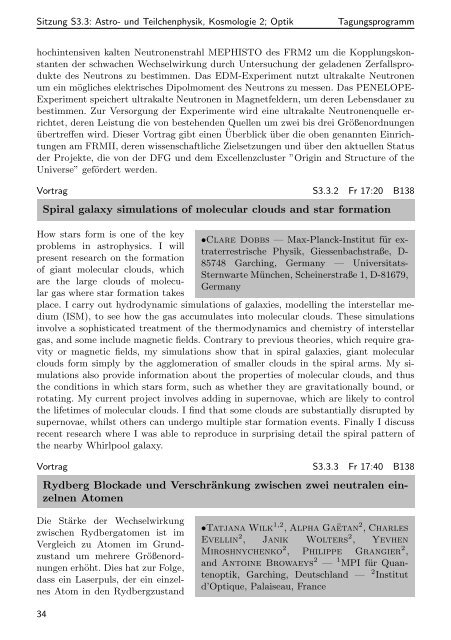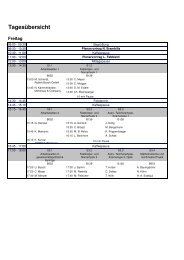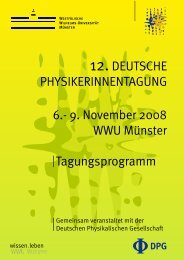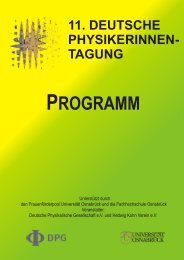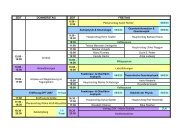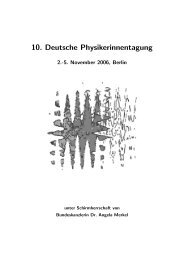Programmheft - Physikerinnentagung
Programmheft - Physikerinnentagung
Programmheft - Physikerinnentagung
Sie wollen auch ein ePaper? Erhöhen Sie die Reichweite Ihrer Titel.
YUMPU macht aus Druck-PDFs automatisch weboptimierte ePaper, die Google liebt.
Sitzung S3.3: Astro- und Teilchenphysik, Kosmologie 2; Optik Tagungsprogramm<br />
hochintensiven kalten Neutronenstrahl MEPHISTO des FRM2 um die Kopplungskonstanten<br />
der schwachen Wechselwirkung durch Untersuchung der geladenen Zerfallsprodukte<br />
des Neutrons zu bestimmen. Das EDM-Experiment nutzt ultrakalte Neutronen<br />
um ein mögliches elektrisches Dipolmoment des Neutrons zu messen. Das PENELOPE-<br />
Experiment speichert ultrakalte Neutronen in Magnetfeldern, um deren Lebensdauer zu<br />
bestimmen. Zur Versorgung der Experimente wird eine ultrakalte Neutronenquelle errichtet,<br />
deren Leistung die von bestehenden Quellen um zwei bis drei Größenordnungen<br />
übertreffen wird. Dieser Vortrag gibt einen Überblick über die oben genannten Einrichtungen<br />
am FRMII, deren wissenschaftliche Zielsetzungen und über den aktuellen Status<br />
der Projekte, die von der DFG und dem Excellenzcluster ”Origin and Structure of the<br />
Universe” gefördert werden.<br />
Vortrag S3.3.2 Fr 17:20 B138<br />
Spiral galaxy simulations of molecular clouds and star formation<br />
How stars form is one of the key<br />
problems in astrophysics. I will<br />
present research on the formation<br />
of giant molecular clouds, which<br />
are the large clouds of molecular<br />
gas where star formation takes<br />
•Clare Dobbs — Max-Planck-Institut für extraterrestrische<br />
Physik, Giessenbachstraße, D-<br />
85748 Garching, Germany — Universitats-<br />
Sternwarte München, Scheinerstraße 1, D-81679,<br />
Germany<br />
place. I carry out hydrodynamic simulations of galaxies, modelling the interstellar medium<br />
(ISM), to see how the gas accumulates into molecular clouds. These simulations<br />
involve a sophisticated treatment of the thermodynamics and chemistry of interstellar<br />
gas, and some include magnetic fields. Contrary to previous theories, which require gravity<br />
or magnetic fields, my simulations show that in spiral galaxies, giant molecular<br />
clouds form simply by the agglomeration of smaller clouds in the spiral arms. My simulations<br />
also provide information about the properties of molecular clouds, and thus<br />
the conditions in which stars form, such as whether they are gravitationally bound, or<br />
rotating. My current project involves adding in supernovae, which are likely to control<br />
the lifetimes of molecular clouds. I find that some clouds are substantially disrupted by<br />
supernovae, whilst others can undergo multiple star formation events. Finally I discuss<br />
recent research where I was able to reproduce in surprising detail the spiral pattern of<br />
the nearby Whirlpool galaxy.<br />
Vortrag S3.3.3 Fr 17:40 B138<br />
Rydberg Blockade und Verschränkung zwischen zwei neutralen einzelnen<br />
Atomen<br />
Die Stärke der Wechselwirkung<br />
zwischen Rydbergatomen ist im<br />
Vergleich zu Atomen im Grundzustand<br />
um mehrere Größenordnungen<br />
erhöht. Dies hat zur Folge,<br />
dass ein Laserpuls, der ein einzelnes<br />
Atom in den Rydbergzustand<br />
34<br />
•Tatjana Wilk 1,2 , Alpha Gaëtan 2 , Charles<br />
Evellin 2 , Janik Wolters 2 , Yevhen<br />
Miroshnychenko 2 , Philippe Grangier 2 ,<br />
and Antoine Browaeys 2 — 1 MPI für Quantenoptik,<br />
Garching, Deutschland — 2 Institut<br />
d’Optique, Palaiseau, France


